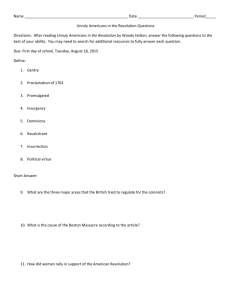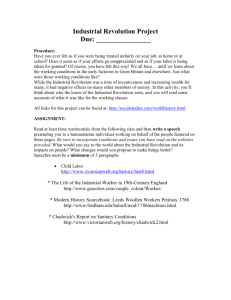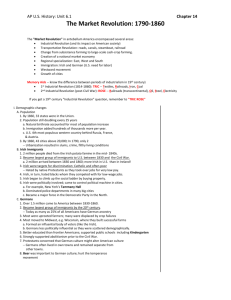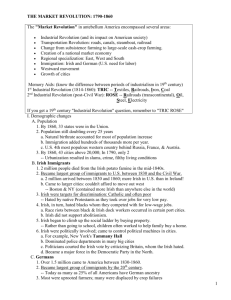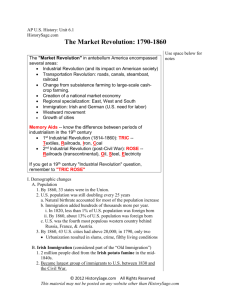The Market Revolution Study Guide
advertisement
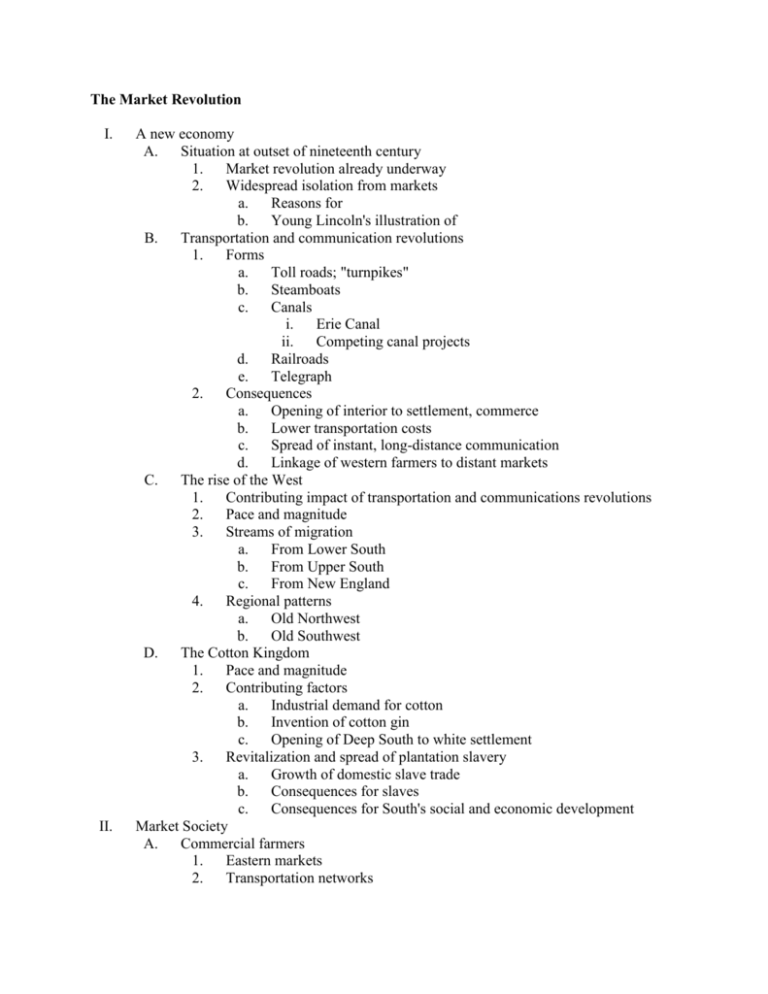
The Market Revolution I. II. A new economy A. Situation at outset of nineteenth century 1. Market revolution already underway 2. Widespread isolation from markets a. Reasons for b. Young Lincoln's illustration of B. Transportation and communication revolutions 1. Forms a. Toll roads; "turnpikes" b. Steamboats c. Canals i. Erie Canal ii. Competing canal projects d. Railroads e. Telegraph 2. Consequences a. Opening of interior to settlement, commerce b. Lower transportation costs c. Spread of instant, long-distance communication d. Linkage of western farmers to distant markets C. The rise of the West 1. Contributing impact of transportation and communications revolutions 2. Pace and magnitude 3. Streams of migration a. From Lower South b. From Upper South c. From New England 4. Regional patterns a. Old Northwest b. Old Southwest D. The Cotton Kingdom 1. Pace and magnitude 2. Contributing factors a. Industrial demand for cotton b. Invention of cotton gin c. Opening of Deep South to white settlement 3. Revitalization and spread of plantation slavery a. Growth of domestic slave trade b. Consequences for slaves c. Consequences for South's social and economic development Market Society A. Commercial farmers 1. Eastern markets 2. Transportation networks B. C. D. E. 3. Availability of credit 4. Improved farm machinery The growth of cities 1. Place on western frontier 2. Pace of growth From craft production to mass production 1. Decline of artisan tradition a. Larger workshops b. Subdivision of tasks c. Increased supervision 2. The factory system a. Early enterprises i. Slater factory (Rhode Island) ii. Waltham and Lowell mills (Massachusetts) iii. Spread of industrial towns b. Initial features i. Large concentrations of workers ii. Centralized supervision iii. Water power iv. Power-driven machinery v. "Outwork" c. Evolving features i. Steam power ii. Widening range of locations iii. Widening range of goods iv. Interchangeable parts v. Standardized products d. Regional variations i. Concentration of early industry in New England ii. Small-scale manufacturing elsewhere in North iii. Minimal industrialization in South The industrial worker 1. Sharpening of line between work time and leisure time 2. From labor's "price" to labor's "wage" 3. Early aversion of working men to wage labor 4. The Mill Girls; Women at Lowell The growth of immigration 1. Flow of 2. Factors behind a. Access to jobs and land in North b. Displacement of peasants and craft workers in Europe c. Advances in long-distance travel d. Appeal of American freedoms e. Irish potato famine 3. Experience of a. Irish III. IV. b. Germans c. Others 4. Rise of Nativism a. Chapter in ongoing American anxiety over immigration b. Perception of Irish as subversive to ideals of democratic republic c. Anti-immigrant initiatives i. Riots ii. Electoral campaigns F. The transformation of Law 1. Corporate charters 2. Limited liability 3. Charters as contracts 4. Rejection of state-sponsored monopoly 5. Support for state-sponsored competition 6. Exculpation of companies for property damage 7. Affirmation of employer power at workplace 8. Criminalization of strikes The free individual A. The West and "freedom" 1. "Manifest Destiny" 2. Economic mobility B. The Transcendentalists 1. Leading figures a. Ralph Waldo Emerson b. Henry David Thoreau 2. Individualism a. Self-realization b. Self-reliance c. Privacy 3. Relation to market revolution a. Affirmation b. Critique C. Second Great Awakening 1. Manifestations a. Wave of revivals b. Surging numbers of ministers, church members, evangelical sects c. Rev. Charles Grandison Finney 2. Themes and features a. Doctrines of human free will, salvation through good works b. Democratic sensibility c. Popular embrace of Christianity 3. Relation to market revolution a. Affirmation b. Critique The limits of prosperity A. Liberty and Prosperity; Ideals of market revolution B. C. D. E. F. 1. Competition and material advancement as measures of "freedom" 2. The "self-made man" Beneficiaries of market revolution 1. Wealthy bankers, merchants, industrialists, planters 2. Middle-class employees 3. Successful farmers 4. Successful craftsmen 5. Professionals Race and opportunity; Free Blacks and the Market Revolution 1. Discriminatory barriers to opportunity a. Forms b. Impetus behind c. Impact on black status 2. Black institutional life Women and the Market Revolution 1. Decline of home as realm of economic production 2. The "cult of domesticity" a. Separate spheres b. Distinctive ideals of femininity and masculinity 3. Wage-earning women a. Limited rights and options b. Meager terms of labor 4. Middle-class women a. Domestic respectability b. Freedom from household labor Growing concern over effects of market revolution 1. Acquisitiveness as threat to public good 2. Cycle of boom and bust 3. Irregular employment 4. Widening inequalities of living standards 5. Erosion of craft skills 6. Specter of wage dependency; "wage slavery" The early labor movement 1. Forms a. Workingmen's parties b. Unions and strikes 2. Demands a. Access to land, public education b. Higher wages, shorter hours c. Right to organize 3. Underlying values a. Economic autonomy b. Public-spirited virtue c. Social equality





